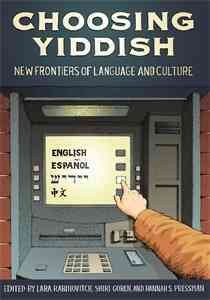| Choosing Yiddish: New Frontiers of Language and Culture Contributor(s): Pressman, Hannah S. (Editor), Rabinovitch, Lara (Editor), Goren, Shiri (Editor) |
|
 |
ISBN: 081433444X ISBN-13: 9780814334447 Publisher: Wayne State University Press OUR PRICE: $36.62 Product Type: Paperback Published: December 2012 |
| Additional Information |
| BISAC Categories: - Literary Criticism | Jewish - Foreign Language Study | Yiddish - Religion | Judaism - General |
| Dewey: 439.1 |
| LCCN: 2012015788 |
| Series: Non-Series |
| Physical Information: 1.1" H x 7" W x 9.9" (1.67 lbs) 360 pages |
| Themes: - Ethnic Orientation - Jewish - Religious Orientation - Jewish |
| Descriptions, Reviews, Etc. |
| Publisher Description: Yiddish Hip Hop, a nineteenth century "Hasidic Slasher," obscure Yiddish writers, and immigrant Jewish newspapers in Buenos Aires, Paris, and New York are just a few of the topics featured in Choosing Yiddish: New Frontiers of Language and Culture. Editors Lara Rabinovitch, Shiri Goren, and Hannah S. Pressman have gathered a diverse and richly layered collection of essays that demonstrates the currency of Yiddish scholarship in academia today. Organized into six thematic rubrics, Choosing Yiddish demonstrates that Yiddish, always a border-crossing language, continues to push boundaries with vigorous disciplinary exchange. "Writing on the Edge" focuses on the realm of belles lettres; "Yiddish and the City" spans the urban centers of Paris, Buenos Aires, New York City, and Montreal; "Yiddish Goes Pop" explores the mediating role of Yiddish between artistic vision and popular culture; "Yiddish Comes to America" focuses on the history and growth of Yiddish in the United States; "Yiddish Encounters Hebrew" showcases interactions between Yiddish and Hebrew in the late nineteenth and twentieth centuries; and "Hear and Now" explores the aural dimension of Yiddish in contemporary settings. Along the way, contributors consider famed and lesser-known Yiddish writers, films, and Yiddish hip-hop, as well as historical studies on the Yiddish press, Yiddish film melodrama, Hasidic folkways, and Yiddish culture in Israel. Venerable scholars introduce each rubric, creating additional dialogue between newer and more established voices in the field. The international contributors prove that the language-far from dying-is fostering exciting new directions of academic and popular discourse, rooted in the field's historic focus on interdisciplinary research. Students and teachers of Yiddish studies will enjoy this innovative collection. |